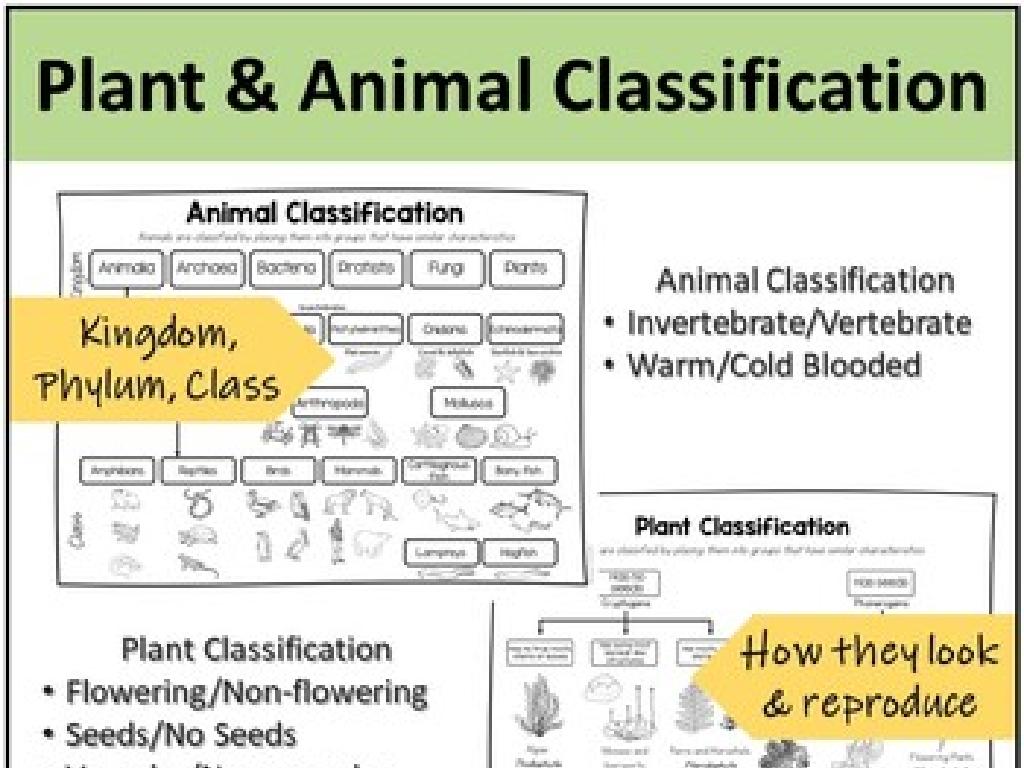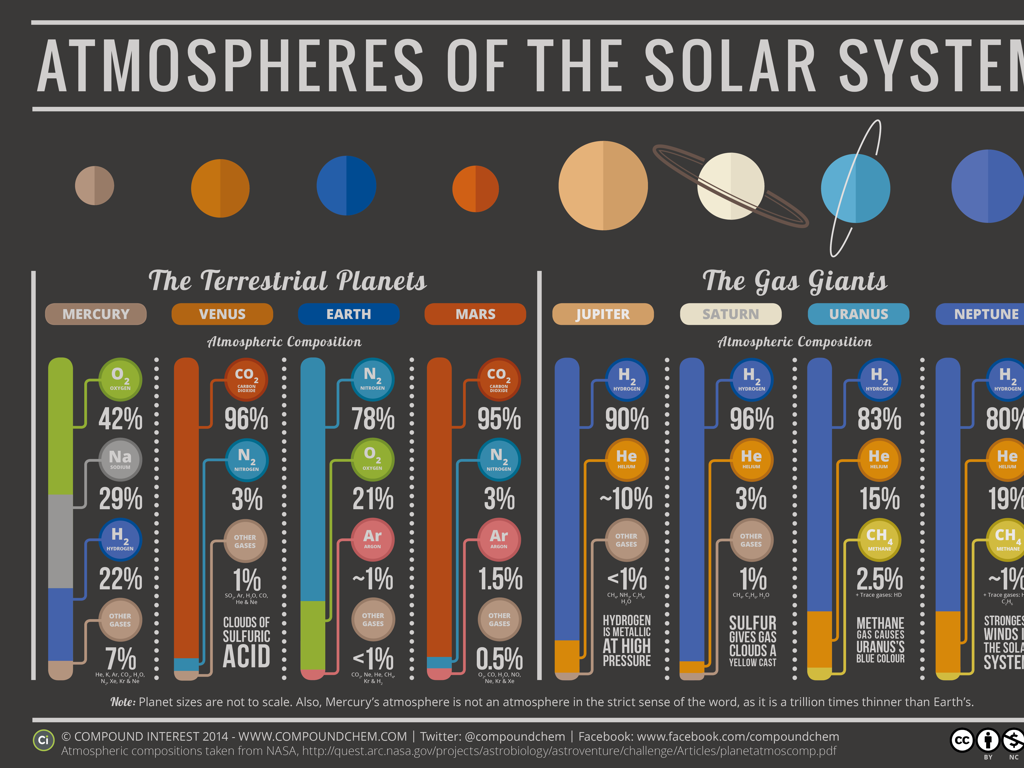Classify Symbiotic Relationships
Subject: Science
Grade: Seventh grade
Topic: Ecological Interactions
Please LOG IN to download the presentation. Access is available to registered users only.
View More Content
Exploring Symbiotic Relationships
– Ecology & our environment
– What are ecological interactions?
– How organisms in an ecosystem interact with each other
– Defining symbiosis
– Symbiosis: a close, long-term interaction between different species
– Types of symbiotic relationships
– Mutualism, commensalism, and parasitism
|
This slide introduces the concept of ecological interactions with a focus on symbiotic relationships. Begin by discussing ecology and its importance in understanding our environment. Explain that ecological interactions are the ways in which organisms in an ecosystem relate to one another. Introduce symbiosis as a key type of ecological interaction, where two different species live in close association. Highlight the three main types of symbiotic relationships: mutualism (both benefit), commensalism (one benefits, the other is unaffected), and parasitism (one benefits at the expense of the other). Use examples to illustrate each type, such as bees and flowers (mutualism), barnacles on whales (commensalism), and ticks on dogs (parasitism). Encourage students to think of other examples they may have observed in nature or at home.
Exploring Symbiosis in Ecosystems
– Define symbiosis
– Long-term interaction between different species
– Symbiosis significance in ecosystems
– Symbiotic relationships are crucial for many organisms’ survival and ecosystem balance
– Examples of symbiotic relationships
– Mutualism: bees and flowers; Commensalism: barnacles on whales; Parasitism: ticks on dogs
– Impact on natural world
|
This slide introduces the concept of symbiosis, a fundamental ecological interaction where two different species live in close physical proximity and interact over a long period. Emphasize the importance of these relationships in maintaining the balance of ecosystems, as they can affect the survival and reproduction of the involved species. Provide clear examples: mutualism, where both species benefit; commensalism, where one benefits without harming the other; and parasitism, where one benefits at the expense of the other. Discuss how these interactions can have far-reaching impacts on the natural world, influencing everything from individual species to entire ecosystems.
Types of Symbiotic Relationships
– Mutualism: both species benefit
– Example: Bees and flowers. Bees get nectar, flowers get pollinated.
– Commensalism: one benefits, other unaffected
– Example: Barnacles on whales. Barnacles get transport, whales are indifferent.
– Parasitism: one benefits, other harmed
– Example: Ticks on dogs. Ticks get blood, dogs can get diseases.
|
This slide introduces students to the concept of symbiotic relationships within ecosystems, which is a key component of ecological interactions. Mutualism is a win-win situation, like bees pollinating flowers while feeding on their nectar. Commensalism involves one organism benefiting while the other is neither helped nor harmed, such as barnacles hitching a ride on a whale. Parasitism is a relationship where one organism benefits at the expense of the other, like ticks feeding on a dog’s blood. Encourage students to think of other examples and discuss how these interactions shape the dynamics of ecosystems.
Mutualism in Symbiotic Relationships
– Mutualism: Bees and Flowers
– Bees get nectar for food, flowers get pollinated
– Mutualism’s role in survival
– Species rely on each other for resources
– Clownfish and Sea Anemones
– Clownfish get protection, anemones get cleaning
– Mutualism benefits both species
|
This slide delves into the concept of mutualism, a type of symbiotic relationship where both species involved benefit. Using the example of bees and flowers, we can illustrate how bees collect nectar for food while simultaneously pollinating flowers, which is crucial for plant reproduction. Emphasize the importance of mutualism in the survival of species, as it often provides essential resources or services. Another vivid example is the relationship between clownfish and sea anemones, where the clownfish are protected from predators by the anemones’ stinging cells, and in return, clownfish clean the anemones and may provide nutrients through their waste. This slide should help students understand that mutualism is a cooperative interaction that is vital for the well-being of many organisms in an ecosystem.
Commensalism: A Symbiotic Relationship
– Exploring bird-tree commensalism
– Birds nest in trees, which provide shelter without harm to the tree.
– Benefits to birds, neutral for trees
– Birds gain protection and a place to live; trees are unaffected.
– Barnacles benefit, whales not harmed
– Barnacles travel and feed by attaching to whales; whales remain unaffected.
– Real-life examples in nature
|
Commensalism is a type of symbiotic relationship where one organism benefits while the other is neither helped nor harmed. An example is birds using trees for nesting; the trees provide a safe place for birds to live without any cost or benefit to themselves. Another example is barnacles on whales; barnacles gain mobility and access to food sources by hitching a ride on the whale, which does not experience any negative or positive effects. Use these examples to help students understand the concept of commensalism and encourage them to think of other similar relationships in nature. Discuss how these interactions play a crucial role in the balance of ecosystems.
Parasitism: A Symbiotic Relationship
– Exploring tick-dog parasitism
– Ticks feed on dog’s blood, harming the dog
– Effects of parasitism on hosts
– Hosts can suffer malnutrition, disease, or weakness
– Tapeworms: A human parasite case
– Tapeworms live in human intestines, absorbing nutrients
– Understanding host-parasite dynamics
|
This slide delves into the concept of parasitism, one of the three main types of symbiotic relationships. Parasitism involves one organism, the parasite, benefiting at the expense of the other, the host. Using the example of ticks on dogs, we can illustrate how parasites can cause harm by feeding on the host’s blood, potentially leading to diseases like Lyme disease. Another example is tapeworms in humans, which reside in the intestines and take nutrients from the host, leading to malnutrition or other health issues. It’s crucial for students to understand that in parasitism, unlike mutualism or commensalism, one party is harmed while the other benefits. Encourage students to think of other examples of parasitism and consider the impact parasites have on their hosts.
Identifying Symbiotic Relationships
– Understanding symbiosis
– Symbiosis: close, long-term interaction between species
– Characteristics of symbiotic types
– Mutualism, commensalism, parasitism: learn the signs
– Class activity: Classify examples
– Work in pairs to categorize given examples
– Discuss findings as a group
– Share your classifications and reasoning
|
This slide introduces the concept of symbiotic relationships within ecosystems. Begin by explaining symbiosis as a close and often long-term biological interaction between two different biological organisms. Highlight the key characteristics of mutualism (both benefit), commensalism (one benefits, the other is unaffected), and parasitism (one benefits at the expense of the other). For the class activity, provide students with examples of symbiotic relationships and ask them to work in pairs to determine the type of symbiosis each example represents. After the activity, facilitate a group discussion where students share their classifications and the evidence that led them to their conclusions. This will help reinforce their understanding and allow them to learn from each other’s reasoning.
Class Activity: Exploring Symbiosis
– Group activity: Classify scenarios
– Discuss findings with the class
– Reflect on symbiosis in nature
Consider how different organisms rely on each other.
– Share the importance of symbiosis
Why is symbiosis vital for ecosystems?
|
This slide introduces a class activity focused on symbiotic relationships. Divide the class into small groups and provide each with different scenarios depicting various symbiotic interactions. Students will analyze and determine whether the relationships are mutualistic, commensalistic, or parasitic. After the group work, bring the class together for a discussion to share their classifications and reasoning. Encourage students to reflect on how symbiosis can affect the survival and well-being of organisms within an ecosystem. Conclude with a discussion on the broader importance of symbiosis in maintaining the balance of nature. Possible activities: 1) Role-play different symbiotic relationships, 2) Create posters illustrating symbiotic pairs, 3) Research and present a real-world example of symbiosis, 4) Debate on the most beneficial type of symbiosis, 5) Write a short story from the perspective of an organism in a symbiotic relationship.
Symbiotic Relationships: Conclusion & Recap
– Recap: 3 symbiotic relationships
– Mutualism, Commensalism, Parasitism
– Symbiosis in ecosystems
– Symbiosis maintains ecosystem balance
– Homework: Local symbiosis example
– Observe and describe a symbiotic relationship near you
|
As we conclude, let’s recap the three types of symbiotic relationships: mutualism, where both species benefit; commensalism, where one species benefits without harming the other; and parasitism, where one benefits at the expense of the other. Understanding these relationships helps us appreciate the complex interactions that sustain healthy ecosystems. For homework, students are tasked to find and describe an example of symbiosis in their local environment, encouraging them to observe nature closely and apply their knowledge practically. This activity will help reinforce the concepts learned and foster a deeper connection with the local ecosystem.





